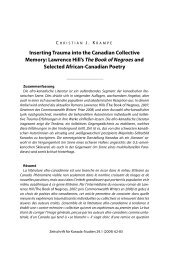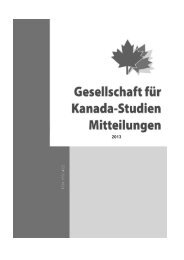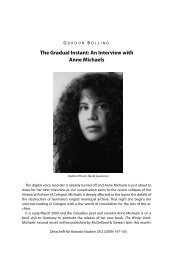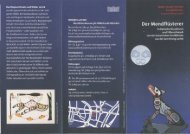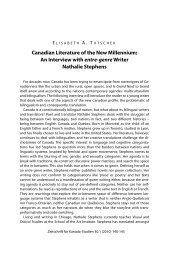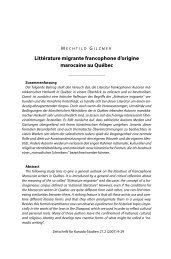The Beginnings of Contemporary Aboriginal Literature in Canada ...
The Beginnings of Contemporary Aboriginal Literature in Canada ...
The Beginnings of Contemporary Aboriginal Literature in Canada ...
Create successful ePaper yourself
Turn your PDF publications into a flip-book with our unique Google optimized e-Paper software.
76 Hartmut Lutz<br />
vidual verse (or l<strong>in</strong>e) <strong>of</strong> the preced<strong>in</strong>g poem which opened the “chapter,” while on all<br />
pages on the right the viewer f<strong>in</strong>ds black and white draw<strong>in</strong>gs , which illustrate,<br />
comment or speak to the verse on the left. <strong>The</strong> first impression is that the red ochre<br />
pages which bear the <strong>in</strong>dividual poems <strong>in</strong> their entirety beg<strong>in</strong> a new self-conta<strong>in</strong>ed<br />
visual unit <strong>of</strong> draw<strong>in</strong>gs next to which their match<strong>in</strong>g verse-l<strong>in</strong>es seem like subtitles,<br />
until the reader realizes that they are the fragmented repetitions, verse by verse and<br />
page by page, <strong>of</strong> the poems s/he has just read. Thus, by the sequential arrangement<br />
<strong>of</strong> texts and icons, the visitor to Sara<strong>in</strong>’s book <strong>of</strong> “ethnic poem-draw<strong>in</strong>gs” is forced to<br />
embark on a de- and reconstructive read<strong>in</strong>g <strong>of</strong> each poem, l<strong>in</strong>e by l<strong>in</strong>e. While some<br />
<strong>of</strong> the draw<strong>in</strong>gs are “naturalistic” and concrete, like those go<strong>in</strong>g with the poem “I<br />
WAS MIXING STARS AND SAND / IN FRONT OF HIM / BUT HE COULDN’T UNDER-<br />
STAND/…,” others are highly abstract, comb<strong>in</strong><strong>in</strong>g icons that seem like traditional<br />
pictographs – which Stump mentions <strong>in</strong> his <strong>in</strong>troduction – with modern iconography,<br />
as <strong>in</strong> the last poem, “LITLLE TRACES IN MY MIND / BROUGHT ME BACK WHERE I<br />
WAS BORN / AND THERE WASN’T ANY EXPLANATION / JUST MY BACK SHOOK / AT<br />
THE CRYING OF MY DYING MOTHER”. It seems fitt<strong>in</strong>g for a visual artist-poet, that he<br />
uses an imagist poetic technique here to convey the unspeakable sadness <strong>of</strong> the<br />
persona by stat<strong>in</strong>g there wasn’t any explanation, but by describ<strong>in</strong>g <strong>in</strong>stead that his<br />
back was heav<strong>in</strong>g. In terms <strong>of</strong> the development <strong>of</strong> Western literary history Sara<strong>in</strong><br />
Stump’s poetry jumps right <strong>in</strong>to modernist art forms, and <strong>in</strong> its <strong>in</strong>tertextual and<br />
genre-bend<strong>in</strong>g comb<strong>in</strong>ation <strong>of</strong> the visual and the verbal, it unselfconsciously or<br />
almost nonchalantly enters the postmodern, which ma<strong>in</strong>stream Canadian <strong>Literature</strong><br />
was just beg<strong>in</strong>n<strong>in</strong>g to approach at the time. Thus, Sara<strong>in</strong> Stump’s book heralds contemporary<br />
<strong>Aborig<strong>in</strong>al</strong> poetry <strong>in</strong> <strong>Canada</strong>, just as his role model George Clutesi heralded<br />
<strong>Aborig<strong>in</strong>al</strong> orature. Later poets are fully aware <strong>of</strong> Stump’s status, and it is fitt<strong>in</strong>g<br />
that the first comprehensive contemporary anthology <strong>of</strong> Native Poetry <strong>in</strong> <strong>Canada</strong><br />
, edited by Jeannette C. Armstrong and Lally Grauer, should use on its cover the<br />
superbly executed image <strong>of</strong> the three “lazy fly<strong>in</strong>’” crows from Stump’s poem.<br />
Perhaps encouraged by Stump’s <strong>The</strong>re Is My People Sleep<strong>in</strong>g, Vancouver’s Daylight<br />
Press <strong>in</strong> 1972 published Skyros Bruce’s (b. 1950) Kalala poems <strong>in</strong> a limited edition <strong>of</strong><br />
250 copies, <strong>of</strong> which 25 were signed by the author. <strong>The</strong> book conta<strong>in</strong>s thirty-seven<br />
untitled but numbered lyrical texts, which are not explicitly “Indian” <strong>in</strong> theme or<br />
structure, but whose impressionist beauty is based on metaphors which the Sleil<br />
Waututh First Nation poet took from nature’s creatures. And 1972 also saw a first<br />
collection <strong>of</strong> poems by Wayne Keon (b. 1946), who together with his father Orville<br />
Keon and his son Ronald Keon published Sweetgrass: An Anthology <strong>of</strong> Indian Poetry, a<br />
tongue-<strong>in</strong>-cheek title which suggests a representational comprehensiveness which<br />
this Anishnabe family collection does not conta<strong>in</strong>. Most <strong>of</strong> the poems are by Wayne<br />
Keon himself, who also provided the sparse ornamental draw<strong>in</strong>gs illustrat<strong>in</strong>g the<br />
texts. While his son Ronald’s rhymed poems are more conventionally Western <strong>in</strong><br />
style, Wayne Keon became perhaps <strong>Canada</strong>’s most experimental modernist <strong>Aborig<strong>in</strong>al</strong><br />
poet. Keon’s highly <strong>in</strong>tellectual and abstract poems repeatedly experiment with



